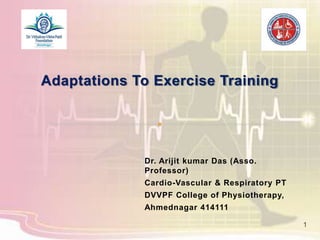
Systemic adaptations to training
- 1. Adaptations To Exercise Training 1 Dr. Arijit kumar Das (Asso. Professor) Cardio-Vascular & Respiratory PT DVVPF College of Physiotherapy, Ahmednagar 414111
- 2. Skeletal system adaptation Endocrine system adaptation Aldosterone & renin-angiotensin mechanism Neuromuscular adaptations Thermoregulation 2
- 4. BONE DENSITY Bone density can be improved , when force of ex is exerted on an area of the skeletal system over a long period of time 4
- 5. HYALINE CARTILAGE Prolonged ex is shown to cause the cartilage on the bone endings to thicken This ↑ses the glide of the joint , thus allowing smooth movt for prolonged time period 5
- 6. LIGAMENTS & TENDONS Ex that consists mainly endurance training strengthens & stiffens the ligaments , reducing the risk of tears & other injury Ex helps restoring mechanical properties of injured ligaments 6
- 9. Hormonal effects on metabolism & energy Carbohydrate & Fat metabolism is responsible for maintaining muscle ATP levels during prolonged ex. Hormones affect glucose & fat metabolism during ex. 9
- 10. Regulation of glucose metabolism during exercise Glucose demands are increased with ex. 2 processes help to meet these demands GLYCOGENOLYSIS GLUCONEOLYSIS 10
- 11. PLASMA GLUCOSE LEVELS Hormones enhancing the above 2 processes are :- GLUCAGON EPINEPHRINE NOREPINEPHRINE CORTISOL 11
- 12. GLUCAGON At rest it facilitates release of glucose from liver During exercise glucagon secretion increases 12
- 13. EPINEPHRINE & NOREPINEPHRINE These hormones along with glucagon increase glycogenolysis Muscular activity during ex increases the rate of release of these hormones 13
- 14. CORTISOL It increases protein catabolism & frees amino acids to be used for gluconeogenesis Cortisol levels increase during ex 14
- 15. GROWTH HORMONE increases mobilization of FFAs & decrease in glucose uptake by cells. THYROID HORMONES promote glucose catabolism & fat metabolism. 15
- 16. GLUCOSE UPTAKE BY THE MUSCLES Insulin facilitates the uptake of glucose by the muscles With prolonged submaximal ex , the plasma insulin levels decrease 16
- 17. Regulation of fat metabolism during exercise During endurance ex bouts , carbohydrate reserves become depleted & body must rely more on the oxidation of fat for energy production. 17
- 18. Hormonal effects on fluid & electrolyte balance during exercise DURING EXERCISE 1. Metabolic by-products accumulate in & around the muscle fibers , increasing the osmotic pressure, d/t which water is drawn into these areas 18
- 19. 2. Increased muscular activity increases BP & drives water out of blood 3. Sweating increases Combined effects of above 3 actions is that the muscles & sweat glands gain water at the expense of PLASMA VOLUME 19
- 20. Two major hormones involved in the regulation of electrolyte balance are :- ALDOSTERONE ADH 20
- 22. 22 1. • Muscular activity promotes sweating & increases BP 2. • Sweating reduces plasma volume & blood flow to kidneys 3. • Reduced renal blood flow stimulates renin release from the kidneys
- 23. 23 4. • Renin leads to the formation of angiotensin I , which is converted to angiotensin II 5. • Angiotensin II stimulates the release of Aldosterone from Adrenal cortex 6. • Aldosterone increases Na+ & H2O reabsorption from the renal tubules & plasma volume increases
- 24. ANTI – DIURETIC HORMONE ( ADH ) 24
- 25. 25 1. • Loss of H2O content from blood during ex , ↑ conc. of blood 2. • Sweating too promotes dehydration which also ↑ plasma conc. 3. • This leads to ↑ in plasma osmolarity
- 26. 26 4. • Osmoreceptors in the hypothalamus sense this ↑ 5. • This triggers ADH release from posterior pituitary 6. • ADH promotes H2O reabsorption in the kidneys , leading to H2O conservation
- 28. Neuromuscular system adaptations occur with CHRONIC EX Extent of adaptations depends on the type of training program:- e.g. Aerobic training e.g. Resistance training 28
- 29. MEASURABLE COMPONENTS OF MUSCULAR FITNESS Muscular strength Muscular power Muscular endurance 29
- 30. RESISTANCE TRAINING & GAINS IN MUSCULAR FITNESS It is based on basic principle of resistance training i.e. “ PRINCIPLE OF PROGRESSIVE OVERLOAD” 30
- 31. RESPONSE OF MUSCLES TO RESISTANCE TRAINING 31
- 32. MUSCULAR CONTROL Cause – effect relationship NEURAL CONTROL Synchronization & recruitment of additional motor units Autogenic inhibition Other neural factors 32
- 33. TRANSIENT HYPERTROPHY It is the pumping of the muscles during single bout of ex Mainly d/t fluid accumulation in interstitial & intracellular spaces of ms. Lasts for short periods (few hrs after ex) 33
- 34. CHRONIC HYPERTROPHY It is d/t longterm resistance training Reflects actual structural changes in ms. Can be d/t foll. reasons :- Fiber hyperplasia(↑ in no. of ms. fibers) 34
- 36. CARDIOVASCULAR FUNCTION 36 1. • During ex “in heat” , there is increase in demand of blood flow to the active muscles & skin 2. • Ex also ↑ metabolic heat production 3. • This excess heat can be dissipated only if blood flow ↑ to skin
- 37. 37 4. • But ↑d demand of active muscles impairs heat transfer to skin 5. • On other hand thermoregulatory center ↑ses blood flow to skin 6. • D/t this superficial blood vessels dilate to ↑ blood flow to skin
- 38. ENERGY PRODUCTION 38 1. • Ex in heat ↑ses O2 uptake 2. • Working muscles use more glycogen & produce more lactate 3. • Causes fatigue & exhaustion
- 39. Skeletal system adaptation Endocrine system adaptation Aldosterone & renin-angiotensin mechanism Neuromuscular adaptations Thermoregulation 39
- 40. 1. WRITE ABOUT ENDOCRINE SYSTEM ADAPTATIONS? 5MARKS 2. WRITE ABOUT SKELETAL SYSTEM ADAPTATIONS? 3MARKS 3. NOTE ON THERMOREGULATIONS. 5MARKS 40
